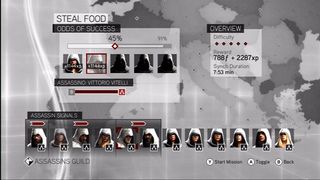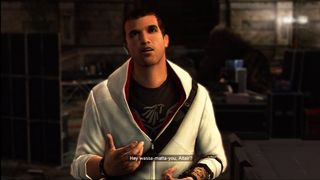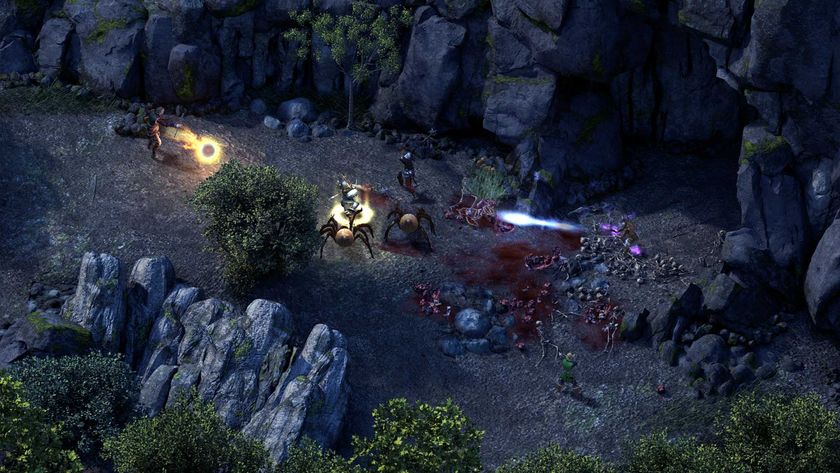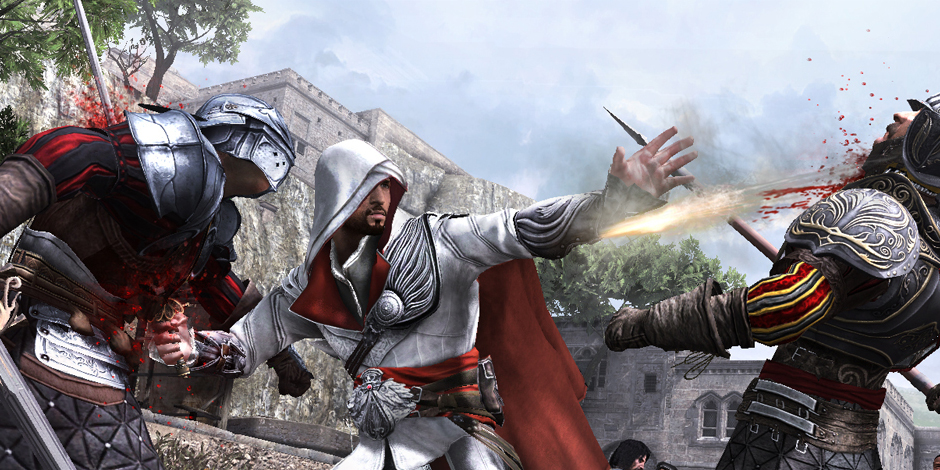12DOVE Verdict
While its story falls short of the bar set by AC2, Brotherhood packs in enough new content to make up for it. Not the best of the series, but it’s still an essential piece of the ever-expanding AC puzzle.
Pros
- +
Enormous
- +
landmark-filled world to explore
- +
Leonardo's machines are a fun change of pace
- +
Uniquely fun multiplayer action
Cons
- -
Story's kind of flat compared to ACII
- -
Visual glitches
- -
occasionally infuriating controls
- -
Waiting for the next game after the WTF ending
Why you can trust 12DOVE
It’s easy to think of Assassin’s Creed: Brotherhood as Assassin’s Creed 2.5, but that’s not quite right. The follow-up to 2009’s Assassin’s Creed II adds more than it changes, true, and it looks and feels virtually identical to its badass, Renaissance-set predecessor. But more than an update, expansion or sequel, Brotherhood feels like the missing second half of ACII.
Big and lengthy enough to stand on its own, Brotherhood is more varied than ACII was, crammed full of cool ideas, gadgets and missions that simply wouldn’t have fit in the last game. It introduces factions, recruitable followers, Leonardo da Vinci-designed war machines, conquerable territory and a ton of optional quests that provide some of the game’s most interesting content. And for an adventure set mainly in a single city (as opposed to ACII’s numerous, sprawling towns), it’s surprisingly huge. Just don’t expect a whole lot of character development or earth-shattering revelations this time around.
To put it another way, if ACII could be summed up like this:

Then Brotherhood is a bit more like this:
Now, where were we?
If you haven’t yet finished Assassin’s Creed II, and have somehow managed to avoid spoilers up to this point, stop reading this now and skip ahead to the next section. In fact, you may want to finish ACII before you even consider starting Brotherhood, because the story picks up exactly where ACII’s left off – which is to say inside a secret, prehistoric vault deep beneath the Vatican.

Above: ZOMG SPOILERS!
From there, it follows the continuing story of Ezio Auditore, the Italian nobleman-turned-killer who we previously took from wet-behind-the-ears kid to grizzled master Assassin. After beating up the incredibly corrupt Pope and receiving an apocalyptic warning from a long-dead precursor civilization (directed, weirdly enough, at his modern-day descendant Desmond Miles), Ezio figures his war is over. With the mind-controlling Apple of Eden in hand, he makes a triumphant return to Monteriggioni, the little fortress town players built up from a relative ruin in ACII.
Of course, it’s not going to last. After a brief interlude that re-introduces most of Ezio’s allies, Monteriggioni falls under a massive siege led by the Pope’s son, Cesare Borgia. With his town shattered by cannon fire and the Apple stolen again, a wounded Ezio sets off for the Borgia seat of power – Rome – to exact revenge.

Above: This stuff with the cannons only really happens once in the entire game, in case you were wondering
When in Rome…
If you’ve played ACII, Brotherhood will feel instantly familiar. As before, you’ll spend most of the game climbing huge, medieval buildings, free-running across rooftops and slaughtering roving packs of guards as you chase down the game’s story missions. You’ll also spend a lot of time riding horses, which is especially fun now that they can be ridden within city limits and summoned with a whistle (just like in Red Dead Redemption, yes).
You still fight by being surrounded by enemies, who then attack one at a time, although there are a few significant additions to the ebb and flow of combat this time around (more on those in a bit). And you’ll still need to reveal the map piece by piece, by climbing up to high “viewpoints” and then synching with the eagles, or whatever it is Ezio does while he’s up there.

Above: You also stab dudes in the face a lot
So what’s new? For starters, there’s the game’s vision of Renaissance Rome, a sprawling metropolis that’s equal parts dense city streets and rural, ruin-filled countryside. Each of its three primary districts feels about as big as one of ACII’s cities, and they’re all filled with accurate-looking recreations of famous Roman ruins and historical sites, like the glittering Pantheon and the massive, crumbling Colosseum. Climbing around on these and discovering their secrets is fun, but what’s perhaps more interesting is that you can actually buy them.
See, Ezio’s out to do more than just assassinate his way to the Borgia clan’s leaders; to truly crush them, he needs to erode their power over Rome’s citizens. This is accomplished by locating one of the 12 Borgia towers, and then killing its attendant captain before climbing the thing and setting it ablaze. Once the tower’s burned, the area around it opens for business, enabling you to buy up the shuttered shops, stables, banks, fast-travel portals and ruins, and reopen them to the public (with a cut of the profits, of course). It’s a bit like rebuilding Monteriggioni in ACII, except on a citywide scale, and it can get surprisingly addictive.

Above: It's enormous, and it can be yours. On paper, anyway...
If commerce isn’t your thing, take heart: like so much else in Brotherhood, it’s largely optional. While Brotherhood’s central story missions are engaging enough (if a little heavy on stealth, escort and oh-so-tedious tailing jobs), its structure is a little unusual, in that its relatively short central story is propped up by a slew of optional tasks, some of which come with their own storylines, and a few of which actually contain some of the game’s best moments.

You could, for example, ignore five of the six Romulus Lairs (Brotherhood’s answer to ACII’s Assassin Tombs) – but then you’d miss out on some expertly designed levels that range from huge, empty environmental puzzles to fight-heavy dungeons filled with creepy guys in wolf headdresses. (You also wouldn’t get access to the best armor in the game.)

Likewise, you could completely pass on the opportunity to help Ezio’s old friend Leonardo da Vinci, who needs you to destroy the war machines he’s been forced to create for the Borgia. But, again, you’d miss out on cool missions that climax with you being able to pilot the inventions, which range from a cart-mounted machinegun and a bomb-equipped flying machine to the goddamn tank we pictured earlier. While they’re a complete departure from the rest of the game, these missions nonetheless make for a cool change of pace – and, unlike the flying-machine missions in ACII, you can replay these whenever you feel like it.

One of the cool things about Brotherhood is that, whether a mission is part of the central storyline or an optional quest, you can replay it once it’s complete – and there’s even an incentive to do so. Aside from your main objective, most missions now carry a secondary one for “full synchronization,” usually something like finishing the mission without being detected, or in a certain amount of time, or killing your target in a certain way. Again, these aren’t necessary to finish the game, but having a secondary goal to shoot for is fun.
Blood on the streets
Secondary mission goals are far from the only improvements Brotherhood brings to the AC formula. The fights have been retooled with a few new moves (and new enemies) as well, with Ezio now able to groin-kick strong opponents to lower their guards, and enemies able to grab and hold Ezio while their buddies beat up on him (which you can wriggle out of with a quick throw). You can also now attack from horseback, which feels really imprecise. But that stuff’s insignificant next to the chainable executions.

If Ezio successfully kills an enemy – most likely through a well-timed reversal – you can then switch his attention immediately to another nearby enemy with a flick of the analog stick, and instantly run them through, no matter how tough or well-armored they might be. These insta-murders can continue in an unbroken streak until your enemies land a successful attack, at which point combat resumes its normal pace. Streaks can be extremely tricky to master, but immensely satisfying to pull off; luckily, if you want to practice them (or just about anything else), there’s a Metal Gear-inspired VR training mode you can access at any time.

Above: Finish every VR mission, and you get a Raiden costume! (No, really)
Interestingly, once you’re at a certain point in the game, even fighting becomes largely optional. About halfway through the story, you’ll earn the ability to recruit followers by helping out citizens the guards are harassing. These recruits can then be trained to become Assassins, starting out as weak apprentices and gradually earning experience until they’ve become near-invincible fighters.
Weak or strong, you can call on up to six of them at virtually any time to swarm your enemies like a pack of hidden-blade-carrying wolves, or to just take out every onscreen baddie at once with a literal hail of arrows. These are particularly useful not just when you want to get out of a jam in a hurry, but also when a mission’s secondary objectives forbid you from killing anyone but your target. After all, it’s not like it’s you doing the killing, right?

Building up your troops is a separate minigame unto itself, seemingly inspired by Metal Gear Solid: Peace Walker’s Outer Ops mode. To earn experience for your recruits, you’ll need to send them on timed missions, selecting from a European map’s worth of tasks and assigning up to five recruits, depending on the mission’s difficulty.

All you need to do then is put up with not having access to some of your recruits until they get back, at which point they’ll have gained experience, money, and possibly some trade goods for you to sell to shopkeepers. It’s weirdly gratifying, especially when it eventually leads to cutscenes of your recruits’ Assassin initiation ceremonies.
Back to the plot
While all that stuff amounts to an enormously fun, involving game, Brotherhood does have one big, glaring flaw: its story. It gets off to an especially strong start, but If you’re looking forward to an awesome narrative on the level of ACII’s, you might be disappointed. There are two big problems at work here, and the first is Ezio himself.
See, part of the reason ACII was so successful was that our view of the game world developed alongside Ezio’s; through his eyes, we saw Florence as a bright playground, Monteriggioni as a dreary ruin (and, later, home) and Venice as an almost intimidatingly bustling city. We also got to see him develop from a cocky, impulsive young charmer into a more mature Assassin, something that really helped us connect with him as a character.
Here, all we’ve got to connect with is the mature Assassin, who comes off much more confident and in control than he was in ACII – and is therefore less interesting.

Above: You will, however, get to see more of young Ezio in the flashback Cristina missions, which reveal more about his ill-fated, mostly offscreen romance in ACII
The other problem is that Rodrigo Borgia (aka Pope Alexander VI), who was built up so effectively as a villain in ACII, barely even appears this time around. For that matter, the control-obsessed Templars don’t even play a very significant role. Instead, Brotherhood focuses on the violent grudge between Ezio and Cesare, who – while a megalomaniacal prick – doesn’t really do too many horrible things onscreen, apart from tearing up Monteriggioni. We’re mostly told how awful he is, which doesn’t do nearly as much to build up a serious hate-on as, say, watching someone murder the hero’s family and friends right in front of him.
(Which Cesare does, to be fair, but only once.)
Cesare’s aided by a handful of prominent sycophants and killers, who – while still being fun to stalk and kill – aren’t as well developed or as interesting as the conspirators of ACII. The only real standouts are Cesare’s sister Lucrezia, who’s portrayed as archly cruel and more than a little unbalanced, and his cousin Juan, a fat, lecherous Cardinal who’s notable mainly for waltzing around in a loincloth when you confront him.

Above: Ew
Oddly enough, most of the charm and character development this time around comes not from Ezio’s storyline, but the other one. You know the one I’m talking about. The one nobody seems to like.
My name is Desmond Miles
If you’ve played previous Creeds, then you already know that the games tend to be split between two narratives: that of Ezio or Altair, and that of their modern-day descendant, Desmond Miles, who’s experiencing their lives through a genome-mining machine called the Animus. As Brotherhood opens, Desmond – who’s on the run from the Templars alongside modern-day Assassins Lucy, Rebecca and Shaun – is brought to a modern version of Monteriggioni, where the team quickly sets up shop.

The good news for Desmond-haters is that, apart from a couple of platforming/puzzle levels at the beginning and end of the game, you never really have to see Desmond at all if you don’t want to. If you do, however, you’re free to leave the Animus at any time from the pause screen, at which point you can explore the town – at night, when nobody’s around, with Desmond’s acrobatic Assassin abilities in full effect.
You can also chat up Desmond’s teammates or (shudder) check his email, which – apart from a couple of late-in-the-game revelations about the other Assassin teams worldwide – doesn’t reveal much aside from what the other characters do in their offscreen time. If you hated checking email in the original, then you’ll be glad to know it can be safely ignored here. If you like the idea of learning a little backstory about the characters, though, it's interesting stuff.

Above: Actual in-game subtitles
What can’t be ignored, however, is what happens after Ezio’s story ends and Desmond’s kicks in again. We won’t spoil it for you, but suffice it to say that there’s a twist cliffhanger at the very end that comes seemingly out of nowhere and left us deeply confused. At this point, we’re looking forward to the sequel just so we can make sense of it.
Also, we should probably warn you not to tense up for any dramatic showdowns between Desmond and the Templars. Instead, you’ll get to play through their Animus-based training program. As them.
Kill your friends
When we first heard about Brotherhood’s idea for multiplayer, it immediately reminded us of The Ship: Murder Party, a 2006 PC game about killing a targeted player while another player hunts for you. While Brotherhood’s concept is similar – you’re tasked with assassinating another player, while some other player (or players) is also hunting you – it’s a bit more complicated than that, not least because of all the onscreen data you’ll have to take in at once.

Each multiplayer match takes place in a medium-sized, town-like map populated not just by other players, but also crowds of civilians who all look just like the player characters. Since you won’t normally be able to detect each other on sight, the key is to try and blend in with the civilians,follow your radar and keep an eye out for anything that might give your intended victim away. (If you see someone running or walking around on a rooftop, for example, that’s a dead giveaway that they’re another player.) Kill the wrong person – or, worse, get killed yourself, or stunned by your intended prey – and you’ll lose your “contract,” and will have to wait to be assigned a new one.
It’s a fantastically challenging setup, and one that can either be extremely rewarding (if your minutes of careful plodding, hiding and misdirection lead to a gruesome kill) or immensely frustrating (if someone else kills you when your kill is within reach). Luckily, you won’t be limited to just feeling your way through crowds blindly; as you level up, you’ll gradually unlock new abilities and perks that range from new weapons (which net you more points when you use them successfully) and faster running to disguises, smoke bombs and Templar Vision, which enables you to instantly spot other players.

Above: This is what happens when you find a stranger in the Alps!
Brotherhood’s multiplayer isn’t just limited to single players hunting each other, either. That mode is called Wanted, and more adventurous players can try Advanced Wanted, which gives you even fewer clues about where your assassination target is. There’s also Alliance, which puts you on a team with another player and tasks you with hunting a second team, while a third team hunts you both; and Manhunt, in which two teams of up to four players take turns hiding from and hunting each other. So long as you’ve got the patience to slowly stalk your kills and gradually level up to the good stuff, multiplayer is definitely one of Brotherhood’s high points.
Assassin’s Creed II?
No. If it were just a matter of pure gameplay, it would be; Brotherhood brings a raft of improvements and cool add-ons, not the least of which is its multiplayer action. But the things that made ACII so compelling were its story and characters, two areas where Brotherhood falls short. It's not that the story’s hugely disappointing; just that, after the epic narrative of ACII, we really expected more.
Fable 3?
Yes. Even disregarding complaints about Fable III’s length, Brotherhood’s Rome feels more like a coherent, living world than Fable’s Albion, its fights are more enjoyable and varied, and its action centers around rapidly climbing buildings, something Fable III completely lacks. It also features a whole hell of a lot fewer fetch quests, which is something we can get behind.
Red Dead Redemption?
No. While it doesn’t have AC’s free-running or hidden-blade stabbings, Rockstar’s Western epic looks better, is overall more fun, and has a much deeper and more involving story. Brotherhood holds up pretty well next to it, but being an Old West outlaw is still more compelling than being a Renaissance one. (Also, Brotherhood doesn’t yet have a world-altering, zombie-filled DLC package, and that’s something it might not hurt to remedy.)
More info
| Genre | Action |
| Description | A spinoff sequel to Assassin's Creed II that will star Ezio as he leads the order of Assassins to conquer Rome. |
| Franchise name | Assassin's Creed |
| Platform | "PC","Xbox 360","PS3" |
| US censor rating | "Mature","Mature","Mature" |
| UK censor rating | "18+","18+","18+" |
| Alternative names | "AC Brotherhood","" |
| Release date | 1 January 1970 (US), 1 January 1970 (UK) |













Andor showrunner hopes that the Disney Plus show's success helps convince Lucasfilm to sign off on either a Star Wars horror movie or sitcom

10 years later, in a post-Baldur's Gate 3 and Avowed world, Obsidian is giving its own throwback CRPG Pillars of Eternity a turn-based combat mode

The OG Fox X-Men are back, with Patrick Stewart, Ian McKellen, and more joining the cast of Avengers: Doomsday alongside a whole new Avengers team to take on Robert Downey Jr's Doctor Doom





